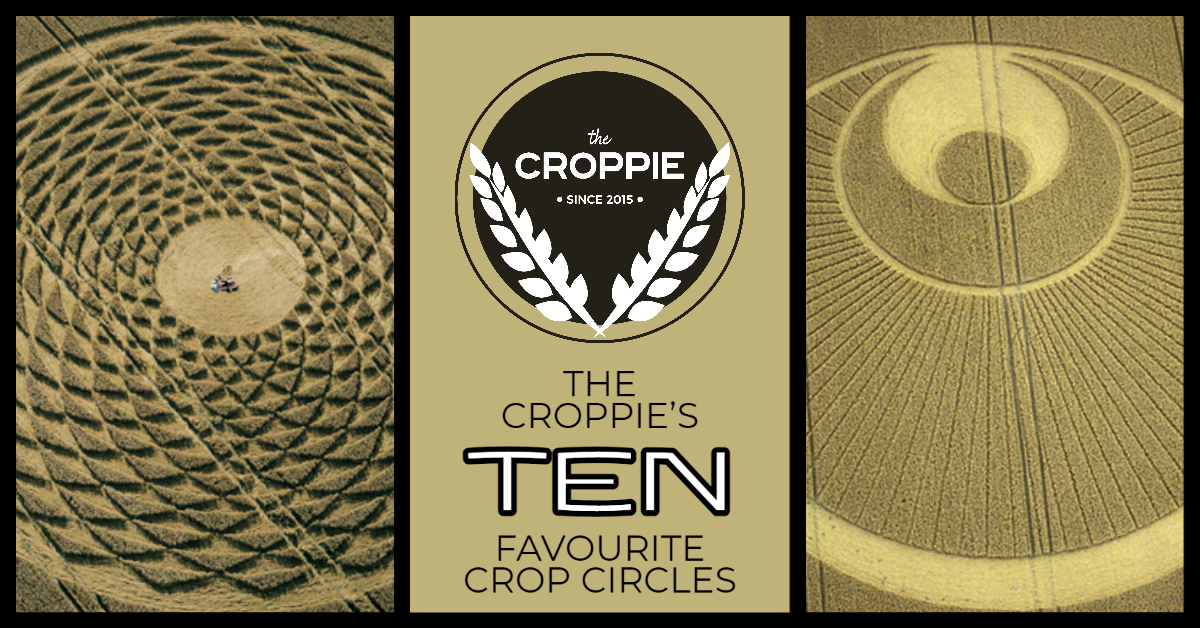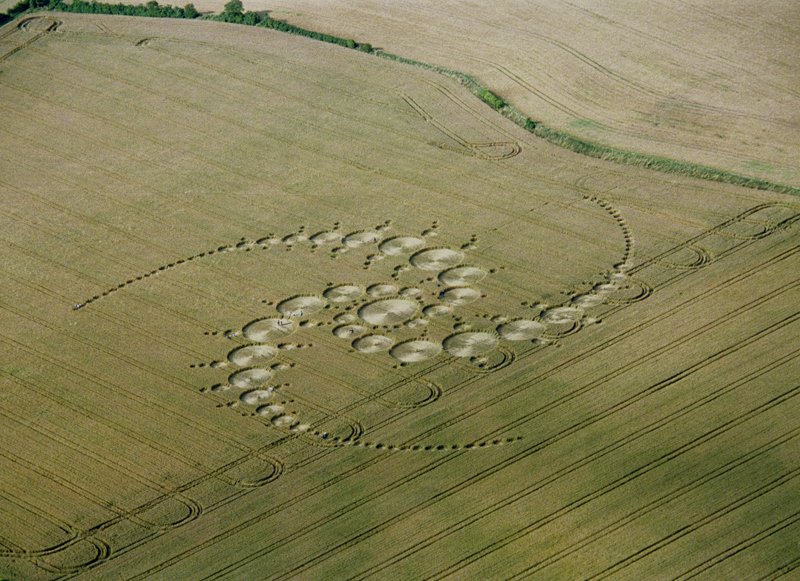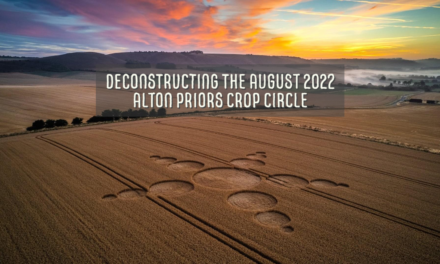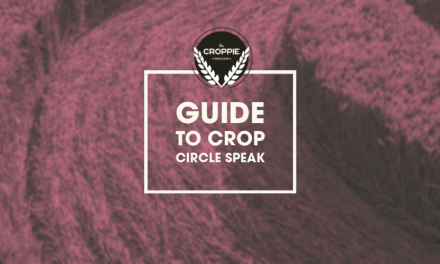
Dear Croppie: What are your favourite crop circles?

Photograph by Hugh Newman
DETAILS
Through a Q&A session on the Crop Circle Explorer Instagram account some of you wanted to know what The Croppie‘s favourite crop circles are. Here are The Croppie‘s favourite five:
10. Alton Barnes White Horse, Wiltshire (June 2009)

Photograph by Steve Alexander
This is the first crop circle I ever set foot inside, despite having been a circles hunter since 2000. It’s on this list for that reason. It is a circle that will always stay with me despite it being ugly, graceless and contrived.
Until that day I’d felt a bit uncertain of walking into a field and damaging the crop underneath my feet. Even though it was a damp, misty morning I still enjoyed the experience. I recall walking down the tentacle like arms and trying to make some sense of these enormous limbs. I came back in warmer weather and was accosted by a woman removing heads of wheat for use in her homeopathic remedies. I wasn’t to step in certain places as she needed the grain from these areas where ‘the energy is the strongest’. She then tried to sell me some of these ‘essences’ from the previous year’s circles that she’d visited. There were also some people in white robes who arrived shortly after, following their leader who was beating a drum. And there were the usual people debating the circle’s origins, albeit those arguing alien creation versus a kind of Gaia theory. Until then I hadn’t really understood how spiritually invested croppies could be in the circles. It was an education and one that I didn’t recognise as positive until a few years later.
9. Honeystreet, Wiltshire (June 2004)

Honeystreet, Wiltshire; June 2004. Photograph by Steve Alexander
An unembellished, minimalist and graceful crop circle that has always captured my attention.
8. Westbury, Wiltshire (July 1990)

Photograph from BBC News
I was 15 when the Operation Blackbird cameras started watching the fields under the White Horse at Westbury in Wiltshire, hoping to catch a circle being made. This was 1990 when Britain had gone completely insane for the circles appearing across Wiltshire. Living in the BBC West television area I’d grown up seeing them on the evening news most summers and now I was hopeful we’d see evidence of what I firmly suspected would be UFOs working their magic. My grandad and uncle had told me not to be so silly, that there was no way the aliens would be involved.
We all know what happened at Blackbird. Very human circle makers left a rough pictogram adjacent to the railway line on the Lower Westbury Road. Celebrity cerealogist Colin Andrews all but declared the circle genuine before examining it and was subsequently left covering his tracks in front of the television cameras. The nation collectively laughed at Andrews and I was one of those kids whose heart was broken … for the first time I accepted that people can make crop circles.
With all this in mind perhaps I should hate this formation but, through the years, I’ve come to love it. By contemporary standards it’s rough, crude and shoddily made. It should have been obvious to Colin Andrews that he was dealing with a hoax, but he was so desperate to be the man in the spotlight that he allowed his ego to take priority over a reasoned assessment of the circle. This left me with so many questions: Was Andrews full of shit? Could all crop circles be made by people? Who had made this one? Had some higher authority set Andrews up to fail?
The 1990 Operation Blackbird crop circle was the one that made me ask questions of the phenomenon and those who claimed to have the answers. As such, I view it as the most important I’ve examined in detail … and I love that I have absolutely no idea who was responsible!
7. Woodborough Hill, Alton Priors, Wiltshire (August 2000)

Photograph by Steve Alexander
Positioned between Picked Hill and Woodborough Hill in classic crop circle territory, this formation is reminiscent of a sunflower head. It’s a classic example of sacred geometry at play inside a circle design; gorgeously simple and extremely beautiful in appearance. I find it very easy to get lost in the spirals.
6. East Field, Alton Priors, Wiltshire (June 1996)

East Field, Alton Priors, Wiltshire; June 1996. Photograph by Steve Alexander
In retrospect, 1996 was an important year for crop circles marking a significant evolution in terms of their designs. We had the Julia and Triple Julia fractals and, alongside them, this apparent representation of DNA. I can’t remember where I first saw this particular formation, but it immediately caught my attention, hinting at the fantastic things to come.
According to croppie Peter Sorensen, the formation consists of 89 individual circles. Whilst this pales alongside the 400 at Milk Hill five years later, the double helix remains a fantastic achievement. It’s a real shame that this circle has been largely forgotten given how important it remains in the phenomenon’s progression.
5. Great Shelford, Cambridgeshire (July 2001)

Photograph by Steve Alexander
In my view the most elegant crop circle of all time, going to show that beauty and complexity are not mutually exclusive.
I have always been puzzled why this circle was the backdrop of the pub sign at The Barge Inn given how it appeared in Cambridgeshire. Then again, perhaps it’s down to how easy this circle is on the eye.
4. Silbury Hill, near Avebury, Wiltshire (July 2009)

Photograph by Steve Alexander
Look closely and you’ll see this crop circle isn’t as perfect as it may initially seem (more on that another time) but it remains a beautiful example of what’s possible in the fields. It also comes complete with a tale of a police officer apparently seeing humanoids in the field on the morning of the circle’s discovery. For me this is what the crop circles are all about.
3. Windmill Hill, near Avebury, Wiltshire (July 1996)

Photograph by Steve Alexander
I’ve continually been drawn to the Windmill Hill ‘Triple Julia’ since I first saw it in a UFO related magazine in late 1996. I immediately fell for its three spiral arms; they seem aggressive in shape but represent the high point of not only fractal inspired formations, but the entire crop circle phenomenon of the mid-1990s.
2. Crab Wood, Winchester, Hampshire (August 2002)

Photograph by Steve Alexander
Although I had Internet access in 2002 I was completely unaware of circles reporting websites like the Crop Circle Connector. I would head off down to the Marlborough Downs and Vale of Pewsey once a year, blind as it were, in the hope of viewing a circle from a hilltop. It was at the very end of August when I made my 2002 visit. I was late to the party and called by the Crop Circle Cafe at Cherhill disappointed to have missed the show. Whilst eating I flicked through the pages of a newsletter — I can’t remember what it was called — featuring the now legendary Crab Wood formation on the front cover. I was immediately reminded of the detail and intricacies of the previous year’s Chilbolton circles, but this new formation seemed to take things to an entirely new level.
The Crab Wood circle consists of a grey alien holding a disk in which a binary message is encoded. It reads ‘Beware the bearers of false gifts and their broken promises. Much pain but still time. There is good out there. We oppose deception. Conduit closing.’
This message continues to entrance croppies some twenty years after it initially appeared and its brilliance lies within its ambiguity. What seems like a plea for unity has actually caused a fair amount of debate and argument between croppies. Who are the bearers of false gifts who break their promises? Cerealogists, circle makers, politicians? There are various interpretations to be had. Similarly, what is the deception spoken of in the disk? And what of the closing conduit? Are the crop circles coming to an end, or is it simply the end of the message? There is so much to be taken from this crop circle that it will always be a personal favourite.
1. Chilbolton Observatory, Hampshire (August 2001)

Photograph by Steve Alexander
I view the two crop circles that appeared next to Chilbolton Observatory as possibly the cleverest of all time. They were both reported on the same day, leading some to assume they had both been created on the same night. I know it’s almost certainly not the case, but I still view the pair as a package. I didn’t visit either of the circles (I was unaware of circles reporting websites) but I remember seeing aerials of them on television and being entranced. These weren’t just patterns in a field … they seemed to hold some genuine meaning. They turned me into something of a believer again; for a while I couldn’t get my head around the idea people could be responsible for creating these. These were crop circles on a higher level. I later saw them in a UFO magazine that autumn and spent the best part of thirty minutes examining their every detail.
One of the circles was a rectangle containing a representation of a human face. It consisted of numerous tufts of standing crop; the design having been constructed around a diagonal grid. It’s laughable that someone can easily dismiss this formation as nothing more than a ‘simple dot matrix’, it must have been a painstaking and drawn-out challenge to get it down in the field.
Large photographs of the face really don’t do it justice. Step back away from your screen and view it and you get a far better idea of how incredible it is.
It’s possible to make the case that the Wickham Green ‘Turin Shroud’ circles of 2010 outdid the Chilbolton face, but I prefer the aesthetics of the latter.

Photograph by Steve Alexander
The second of the Chilbolton pair is known as the ‘Arecibo reply’, supposedly being an extraterrestrial response to the 1974 radio message beamed into space the Arecibo radio telescope in Puerto Rico. The crop circle largely mirrors the message with alterations to fit the grey alien responders. What really grabs me is the way in which the representation of the Arecibo telescope has been replaced by a replica of the crop circle that appeared at Chilbolton in 2001. It’s extremely cheeky and amusing.





